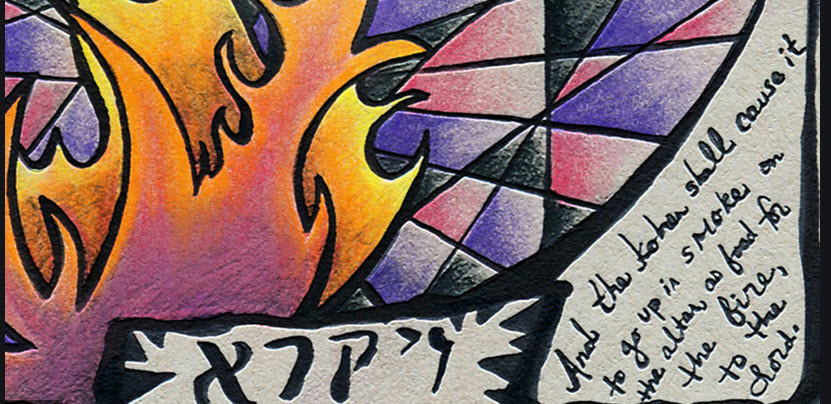|
3/29/2020 Parashat Tzav – Shabbat HaGadol, 5780, 2020: "May the Merciful One Send Us Eliyahu the Prophet"Read Now Rabbi David Etengoff Dedicated to the sacred memories of my mother, Miriam Tovah bat Aharon Hakohen, father-in-law, Levi ben Yitzhak, sister-in-law, Ruchama Rivka Sondra bat Yechiel, sister, Shulamit bat Menachem, Chana bat Shmuel, Yehonatan Binyamin ben Mordechai Meir Halevi, Shoshana Elka bat Avraham, Tikvah bat Rivka Perel, Peretz ben Chaim, Chaya Sarah bat Reb Yechezkel Shraga, the Kedoshim of Har Nof, Pittsburgh and Jersey City, and the refuah shlaimah of Mordechai HaLevi ben Miriam Tovah, Moshe ben Itta Golda, Yocheved Dafneh bat Dinah Zehavah, Reuven Shmuel ben Leah and the safety of our brothers and sisters in Israel and around the world. Our Haftorah contain two well-known pasukim that conclude both Sefer Malachi and the Nevi’im section of Tanach. Herein, Malachi prophesizes the eventual arrival of Eliyahu the prophet who, according to some opinions of Chazal (our Sages), foreshadows the coming of Mashiach Tzidkanu (the Righteous Messiah): Lo, I will send you Elijah the prophet before the coming of the great and awesome day of the L-rd, v’hashiv lave avot al banim — that he may turn the heart of the fathers back through the children, v’lave banim al avotom — and the heart of the children back through their fathers… (Sefer Malachi 3:23-24, this and all Bible translations, The Judaica Press Complete Tanach) The phrases “v’hashiv lave avot al banim” and “v’lave banim al avotom” are difficult to understand, and one feels that they hide more than they reveal. Fortunately, in the context of a discussion of Eliyahu’s task, the Chachamim of the Mishnah suggest the following rationale for these expressions: [Eliyahu the prophet…is coming for solely one purpose:] la’asot shalom ba’olam — to bring peace to the world. As the text states: “that he may turn the heart of the fathers back through the children, and the heart of the children back through their fathers.” (Mishnah Eduyot 8:7, translation and brackets my own) The Rambam (1135-1204) expands upon this statement in a celebrated passage in the Mishneh Torah: … a prophet will arise to inspire Israel to be upright and prepare their minds [to serve the Almighty], as the text states: “Behold, I am sending you Elijah.” He will not come to declare the pure, impure, or to declare the impure, pure. He will not dispute the lineage of those presumed to be of proper pedigree, nor will he validate the pedigree of those whose lineage is presumed blemished. Rather, la’sum shalom ba’olam — he will establish peace in the world as the text continues: “He will turn the hearts of the fathers to the children, [and the heart of the children back through their fathers.”] (Hilchot Melachim 12:2, translation, Rabbi Eliyahu Touger, brackets my own) In sum, the Mishnah and the Rambam interpret the expression “v’hashiv lave” in our verse as la’asot or la’sum shalom ba’olam. What, however, does this mean? In his commentary on the Mishnah, Tifferet Yisrael, Rav Yisrael Lifschitz zatzal (1782-1860) examines the explicit point of focus of our pasukim, namely, fathers and sons, and determines that v’hashiv lave should be interpreted as engendering peace “between man and his fellow man.” In contrast, Rav Yom Tov Lipmann Heller zatzal (1579-1654), in his commentary on the Mishnah entitled Tosafot Yom Tov, interprets la’asot shalom ba’olam in a much wider sense: “In reality, la’asot shalom ba’olam means to make peace between the Jewish people and the other nations of the world…” Thus far we have seen two approaches to understanding the Mishnah’s phrase, la’asot shalom ba’olam. The first is personal, whereas the second refers to peace between the Jewish people and the rest of the world. In my estimation, Eliyahu’s task can be understood in an even broader manner, namely, to bring peace to all humankind. This interpretation is in consonance with a close reading of the Rambam’s text, “la’sum shalom ba’olam — he will establish peace in the world,” an expression that suggests nothing less than universal peace. This idea was given powerful voice by Yeshayahu in one of his most celebrated prophetic visions: “…and they [the nations of the entire world] shall beat their swords into plowshares and their spears into pruning hooks; nation shall not lift the sword against nation, neither shall they learn war anymore.” (Sefer Yeshayahu 2:4) As we say in Birkat Hamazon, “May the Merciful One send us Eliyahu the prophet — may he be remembered for good — and may he bring us good tidings, salvation, and comfort,” and may we witness true and everlasting peace, soon and in our days. V’chane yihi ratzon. Shabbat Shalom Past drashot may be found at my blog-website: http://reparashathashavuah.org They may also be found on http://www.yutorah.org using the search criteria Etengoff and the parasha’s name. The email list, b’chasdei Hashem, has expanded to hundreds of people. I am always happy to add more members to the list. If you have family or friends you would like to have added, please do not hesitate to contact me via email mailto:[email protected]. *** My audio shiurim on the topics of Tefilah and Tanach may be found at: http://tinyurl.com/8hsdpyd *** I have posted 164 of Rabbi Soloveitchik’s English language audio shiurim (MP3 format) spanning the years 1958-1984. Please click on the highlighted link.
0 Comments
 Rabbi David Etengoff Dedicated to the sacred memories of my mother, Miriam Tovah bat Aharon Hakohen, father-in-law, Levi ben Yitzhak, sister-in-law, Ruchama Rivka Sondra bat Yechiel, sister, Shulamit bat Menachem, Chana bat Shmuel, Yehonatan Binyamin ben Mordechai Meir Halevi, Shoshana Elka bat Avraham, Tikvah bat Rivka Perel, Peretz ben Chaim, Chaya Sarah bat Reb Yechezkel Shraga, the Kedoshim of Har Nof, Pittsburgh, and Jersey City and the refuah shlaimah of Mordechai HaLevi ben Miriam Tovah, Moshe ben Itta Golda, Yocheved Dafneh bat Dinah Zehavah, Reuven Shmuel ben Leah and the safety of our brothers and sisters in Israel and around the world. Different Jewish ethnicities have varying traditions regarding the proper way a Torah scroll should be written. Yet, vayikra — the first word of our parasha and the namesake of Sefer Vayikra — is universally written with a diminutive aleph as its final letter. In his commentary on the Torah entitled, Ba’al HaTurim, Rabbeinu Yaakov ben Asher zatzal (1270-1340) provides the following explanation as to why vayikra is written in this way: Moshe was [simultaneously] great and humble. Therefore, he did not want to write “vayikra” (and G-d called), rather, he desired to write “vayikar” (and G-d happened to appear), which is an expression of a purely accidental meeting. By using vayikar, it would be as if Hashem spoke to him in a trance or in a dream, as the Torah states regarding Balaam. [Hashem, however, ruled against this view] and explicitly commanded Moshe to write the aleph [in order to represent his true eminence to the world.] Moshe, however, responded to Hashem— based upon his thoroughgoing humility — and told Him that he would only consent to write a miniature aleph that would be smaller than any other aleph in the Torah; and so he wrote it in this manner. (Translation and brackets my own) According to Rabbeinu Yaakov’s interpretation, there was palpable tension between Hashem and Moshe, as Hashem perceived Moshe in an entirely different manner than Moshe’s view of himself. In the Almighty’s judgment, Moshe was truly great and ever His faithful servant, for with Moshe alone did He: “… speak mouth to mouth; in a [direct] vision and not in riddles.” Moreover, only Moshe, of all the prophets, was able to see marot — visions of the Almighty. (Sefer Bamidbar 12:8, this and all Tanach translations, The Judaica Press Complete Tanach) Clearly, as Moshe was different than any other human being who has ever lived, Hashem sought to give voice to this idea by writing vayikra as the first word of our parasha. In stark contrast, Moshe was so humble that he described Aharon and himself as, “v’nachnu mah — of what significance are we?” (Sefer Shemot 16:7,8) Little wonder, then, that the Torah famously teaches us, “V’ha’ish Moshe anav m’ode mi’kol ha’adam asher al p’nai ha’adamah — Now this man Moshe was exceedingly humble, more so than any person on the face of the earth.” (Sefer Bamidbar 12:3) The last thing Moshe wanted, therefore, was to write vayikra, rather than vayikar. As such, he was faced with a true dilemma: How could he follow the command of the Master of the Universe while remaining existentially true to himself? Moshe’s solution was an elegant compromise: He wrote vayikra with a tiny aleph as its concluding letter, thereby implementing Hashem’s p’sak (decision) while maintaining his personal integrity. Anivut (humility) unmistakably emerges as one of the driving forces of Moshe’s personality. Based upon a variety of midrashic sources, it appears that this middah (ethical characteristic) was woven into his very being. Most of us, however, need to work at developing this middah. We are fortunate that the Ramban (1194-1270) gives us ready guidance as to how to undertake this process: Therefore, I will now explain to you how to always behave humbly. Speak gently at all times… with your heart focusing on Hashem… In all your actions, words and thoughts, always regard yourself as standing before Hashem, with His Schechinah [Divine Presence] above you, for His glory fills the whole world. Speak with fear and awe, as a servant standing before his master. Act with restraint in front of everyone. When someone calls you, don’t answer loudly, but gently and softly, as one who stands before his master. (Iggeret HaRamban, translation, with my emendations, http://www.pirchei.com/specials/ramban/ramban.htm, brackets and italics my own) Two salient points emerge in this section of the Iggeret HaRamban that guide us toward the acquisition of anivut: Our encounters with others should embody respect, and our minds and hearts should be focused upon Hashem with the conscious recognition that we ever stand before His Divine Presence. With the Almighty’s help and our fervent desire, as we follow the Ramban’s roadmap for acquiring anivut, may we fulfill the verse, “And you shall do what is proper and good in the eyes of the L-rd” (Sefer Devarim 6:18). In so doing, may we choose the path that is “harmonious for the one who does it, and harmonious for all humankind.” (Pirkei Avot II:1) V’chane yihi ratzon. Shabbat Shalom Past drashot may be found at my blog-website: http://reparashathashavuah.org They may also be found on http://www.yutorah.org using the search criteria Etengoff and the parasha’s name. The email list, b’chasdei Hashem, has expanded to hundreds of people. I am always happy to add more members to the list. If you have family or friends you would like to have added, please do not hesitate to contact me via email mailto:[email protected]. *** My audio shiurim on the topics of Tefilah and Tanach may be found at: http://tinyurl.com/8hsdpyd *** I have posted 164 of Rabbi Soloveitchik’s English language audio shiurim (MP3 format) spanning the years 1958-1984. Please click on the highlighted link.  Rabbi David Etengoff Dedicated to the sacred memories of my mother, Miriam Tovah bat Aharon Hakohen, father-in-law, Levi ben Yitzhak, sister-in-law, Ruchama Rivka Sondra bat Yechiel, sister, Shulamit bat Menachem, Chana bat Shmuel, Yehonatan Binyamin ben Mordechai Meir Halevi, Shoshana Elka bat Avraham, Tikvah bat Rivka Perel, Peretz ben Chaim, Chaya Sarah bat Reb Yechezkel Shraga, the Kedoshim of Har Nof and Pittsburgh, and the refuah shlaimah of Mordechai HaLevi ben Miriam Tovah, Moshe ben Itta Golda, Yocheved Dafneh bat Dinah Zehavah, Reuven Shmuel ben Leah and the safety of our brothers and sisters in Israel and around the world. The final five parshiot of Sefer Shemot describe every conceivable aspect of the construction of the Mishkan, including its kalim —vessels and utensils — and the bigdei kohanim — the garments worn by both the kohanim and the Kohane Gadol. Within this context we find a number of pasukim wherein the kiyor and its base, the copper washstand used by the kohanim to sanctify themselves, are referenced. One of these verses is quite unusual, as it specifies the exact group from whom the copper for constructing the kiyor was sourced — something that is not found regarding other kalim: “And he [Bezalel] made hakiyor of copper and its base of copper from the mirrors of the legions who congregated at the entrance of the tent of meeting. (38:8, this and all Bible translations, The Judaica Press Complete Tanach) Chazal teach us that “the legions who congregated at the entrance of the tent of meeting” refers to the Jewish women who responded to Hashem’s command to the Jewish people to donate items for the building of the Mishkan. (25:2) They sought to fulfill this mitzvah by bringing their highly polished copper mirrors before Moshe. His reaction to their heartfelt offering, however, was anything but positive: “And when Moshe saw these mirrors, he became angry at them [the women] and declared… ‘Of what possible value are these mirrors!’” (Midrash Tanchuma, Parashat Pekudei IX, this and the following translations my own) What accounts for Moshe’s angry response to the women, especially since the mirrors were given b’nidvat leban — from the depths of their hearts? The answer to this question is found in the opening words of our midrash that explain the exponential population growth of our ancestors during the period of their terrible Egyptian servitude: But as much as they [the Egyptians] would afflict them, so did they [the Jewish people] multiply and so did they gain strength… (1:12) In the merit of the mirrors; they had mirrors [to beautify themselves] for their husbands in order to encourage them to have intimacy with them — even in the midst of their back-breaking labor. It is from these acts that untold numbers of children sprang forth. In his Commentary on the Torah on our pasuk, Rashi (1040-1105) elaborates upon our midrash and states that, “Moshe was disgusted by the mirrors because they were made for the yetzer harah (that is, lustful purposes).” As such, he viewed their origin and use as antithetical to the kedushah that was to reign supreme in the Mishkan — the dwelling place of Hashem’s presence on earth. Our midrash continues by teaching us that the Holy One blessed be He radically disagreed with Moshe and summarily overruled him: Moshe — are you [honestly] willing to reject and degrade the singular import of these [mirrors]? Do you not realize that it is precisely these mirrors that brought about the birth of myriads of Jews in Egypt? No! Take these from them [the women] and make from them [the mirrors] the copper kiyor and its base — for it is precisely from them that the kohanim will sanctify themselves. Quite often, Rashi’s presentation of a midrash will differ from the original text of the midrash in order to allow him to teach what he deems to be a crucial lesson. Our case follows suit when he reframes Hashem’s response to Moshe in the following manner: “The Holy One blessed be He said to him: ‘Accept [the mirrors], for they are more beloved to Me than anything else that has been brought; for it is because of them that the women were able to bring forth myriads of Jews in Egypt.’” Rashi’s restatement is an exegetical tour de force that gives him the freedom to teach us that the copper mirrors of the Jewish women of Egypt were more beloved to the Almighty than gold itself. Little wonder, then, that Talmud Bavli, Sotah 11b, famously states: “Because of the reward of the righteous women that were in that generation [the final generation of Egypt bondage], the Jewish people were redeemed from Egypt.” This is a powerful thought, indeed, and one that enhances our understanding of the depth-level spirituality of the Jewish women in Egypt. May they ever serve as a model of devotion to Hashem. V’chane yihi ratzon. Shabbat Shalom Past drashot may be found at my blog-website: http://reparashathashavuah.org They may also be found on http://www.yutorah.org using the search criteria Etengoff and the parasha’s name. The email list, b’chasdei Hashem, has expanded to hundreds of people. I am always happy to add more members to the list. If you have family or friends you would like to have added, please do not hesitate to contact me via email mailto:[email protected]. *** My audio shiurim on the topics of Tefilah and Tanach may be found at: http://tinyurl.com/8hsdpyd *** I have posted 164 of Rabbi Soloveitchik’s English language audio shiurim (MP3 format) spanning the years 1958-1984. Please click on the highlighted link.  Rabbi David Etengoff Dedicated to the sacred memories of my mother, Miriam Tovah bat Aharon Hakohen, father-in-law, Levi ben Yitzhak, sister-in-law, Ruchama Rivka Sondra bat Yechiel, sister, Shulamit bat Menachem, Chana bat Shmuel, Yehonatan Binyamin ben Mordechai Meir Halevi, Shoshana Elka bat Avraham, Tikvah bat Rivka Perel, Peretz ben Chaim, Chaya Sarah bat Reb Yechezkel Shraga, Shmuel Yosef ben Reuven and the Kedoshim of Har Nof, Pittsburgh and Jersey City, and the refuah shlaimah of Mordechai HaLevi ben Miriam Tovah, Moshe ben Itta Golda, Yocheved Dafneh bat Dinah Zehavah, Reuven Shmuel ben Leah and the safety of our brothers and sisters in Israel and around the world. Parashat Ki Tisa is a multi-themed parasha that includes six pasukim focusing on our people’s singular relationship to Shabbat. I find one of these particularly intriguing: “V’shamru b’nai Yisrael et HaShabbat — The Jewish people shall keep the Shabbat, la’asot et HaShabbat — to make the Shabbat throughout their generations as an eternal covenant.” (31:16) We are immediately met with a classic exegetical challenge: If the Torah deploys the word “v’shamru,” why does it also need, “la’asot?” The Ibn Ezra (1089-1167) often presents peshat-level (direct) analyses of Torah expressions. He follows suit regarding our pasuk when he explains v’shamru as: the Jewish people’s obligation to concentrate upon (literally, to guard) the days of the week so that they will not forget which day is Shabbat. In so doing, they will be able to prepare all of its needs — and hone their approach toward keeping Shabbat by the sixth day of the week — in order to guard the integrity of Shabbat and refrain from violating its kedushah — holiness. (Translation my own) For the Ibn Ezra, v’shamru connotes keen focus on the days of the week preceding Shabbat to ensure that we maintain the proper levels of shmirah — watchfulness and preparation — to safeguard its kedushah. Little wonder, then, that he perceives la’asot as a natural extension of v’shamru, and finds its parallel in an earlier pasuk wherein la’asot is used regarding Avraham’s alacrity in preparing a meal for his guests (that is, the three Angels): “And to the cattle did Abraham run, and he took a calf, tender and good, and he gave it to the youth, va’yimahare la’asot oto — and he hastened to prepare it.” (Sefer Bereishit 18:7, translation, The Judaica Press Complete Tanach) In his Commentary on the Torah on our verse, Rabbeinu Bachya ben Asher (1255-1340) follows the Ibn Ezra’s general approach regarding the relationship that obtains between v’shamru and la’asot. He does more, however, than merely provide us with a reframe of the Ibn Ezra’s words, and cites a thought-provoking midrashic statement that does not appear in any of our standard collections of Midrashim: la’asot et HaShabbat: “Kol hameshamare — Anyone who guards — the Shabbat in this world k’eilu asah — is as if they have made it — in the Heavens above.” He explains this aphoristic sentence in the following manner: One who fulfills the mitzvah of Shabbat in this world bears testimony that they recognize and believe that Shabbat’s roots and essence were [eternally] engraved from above [by the Almighty] …This, then, is why the Torah writes, la’asot et HaShabbat. (Translation and brackets my own) Rabbeinu Bachya’s explanation of the midrash teaches us a central lesson, namely, that when the Jewish people guard the integrity of Shabbat — v’shamru — and honor it in this world, we demonstrate our recognition and belief “that Shabbat’s roots and essence were engraved from above.” The ongoing act of la’asot et HaShabbat, therefore, denotes our connection to Shabbat both in our world and the Heavens above, and enables us to bring glory to Hashem’s holy Name. The following deeply insightful midrashic passage discusses the unique link between Shabbat and the Jewish people, and brings our understanding to an entirely new level: Rabbi Shimon ben Yochai taught: “Shabbat spoke before the Holy One blessed be He and said: ‘Master of the Universe, every other day of the week has a ben zug — corresponding partner — yet, I have no partner!’ The Holy One blessed be He responded to her: ‘Knesset Yisrael [the transhistorical community of the Jewish people] is your ben zugach [and you are, therefore, not alone].’ And when the Jewish people stood before Mount Sinai, the Holy One blessed be He said to them: ‘Remember what I told Shabbat [when I created the world] — “Knesset Yisrael is your corresponding partner…’” (Midrash Bereishit Rabbah 11:8, translation and brackets my own) Rabbi Shimon ben Yochai teaches us that Shabbat’s eternal relationship with Knesset Yisrael, and our exclusive connection to her, is built into the very fabric of the Universe. Like the relationship between husband and wife, we are Shabbat’s ben zugach, and she is our ben zug. While the famous words of Shlomo HaMelech (King Solomon) in Shir HaShirim, “ani l’dodi v’dodi li — I am my beloved’s and my beloved is mine,” are almost always interpreted as referring to Hashem and the Jewish people, Rabbi Shimon ben Yochai informs us that they can refer as well to the inextricable connection that obtains between Shabbat and the Jewish people. Perhaps a more beautiful and inspiring idea has yet to be found. Shabbat Shalom Past drashot may be found at my blog-website: http://reparashathashavuah.org They may also be found on http://www.yutorah.org using the search criteria Etengoff and the parasha’s name. The email list, b’chasdei Hashem, has expanded to hundreds of people. I am always happy to add more members to the list. If you have family or friends you would like to have added, please do not hesitate to contact me via email mailto:[email protected]. *** My audio shiurim on the topics of Tefilah and Tanach may be found at: http://tinyurl.com/8hsdpyd *** I have posted 164 of Rabbi Soloveitchik’s English language audio shiurim (MP3 format) spanning the years 1958-1984. Please click on the highlighted link. |
Details
Archives
July 2024
AuthorTalmid of Rabbi Soloveitchik zatzal Categories |
- Blog: Rabbi David Etengoff: Parashat HaShavuah
- Sefer Bereishit 5784&5785
- Sefer Shemot 5784&5785
- Sefer Vayikra 5784&5785
- Sefer Bamidbar 5784 &5785
- Sefer Bereishit 5782&5783
- Sefer Shemot 5782&5783
- Sefer Vayikra 5782&5783
- Sefer Bamidbar 5782&5783
- Sefer Devarim 5782&5783
- Sefer Bereishit 5780& 5781
- Sefer Shemot 5780&5781
- Sefer Vayikra 5780&5781
- Sefer Bamidbar 578&5781
- Sefer Devarim 578&5781
- Sefer Bereishit 5778&5779
- Sefer Shemot 5778&5779
- Sefer Vayikra 5778&5779
- Sefer Bamidbar 5778&5779
- Sefer Devarim 5778&5779
- Sefer Bereishit 5776&5777
- Sefer Bereishit 5774&5775
- Sefer Bereishit 5772&5773
- Sefer Bereishit 5771&5770
- Sefer Shemot 5776&5777
- Sefer Shemot 5774&5775
- Sefer Shemot 5772&5773
- Sefer Shemot 5771&5770
- Sefer Vayikra 5776&5777
- Sefer Vayikra 5774&5775
- Sefer Vayikra 5772&5773
- Sefer Vayikra 5771&5770
- Sefer Bamidbar 5776&5777
- Sefer Bamidbar 5774&5775
- Sefer Bamidbar 5772&5773
- Sefer Bamidbar 5771&5770
- Sefer Devarim 5776&5777
- Sefer Devarim 5774&5775
- Sefer Devarim 5772&5773
- Sefer Devarim 5771&5770
 RSS Feed
RSS Feed
